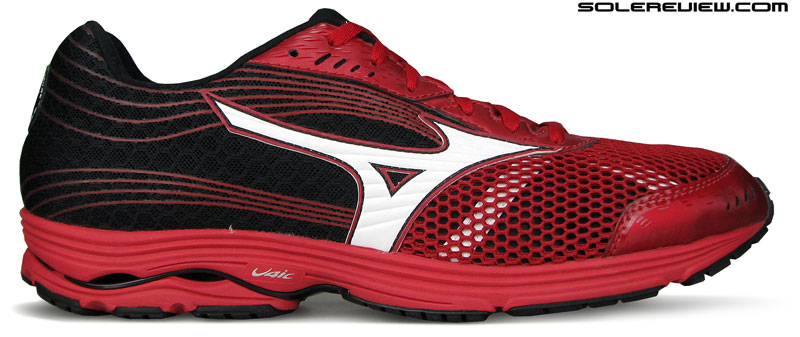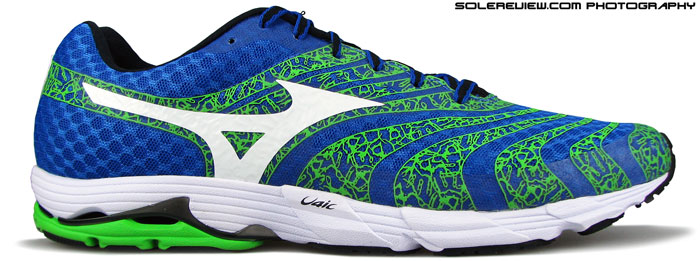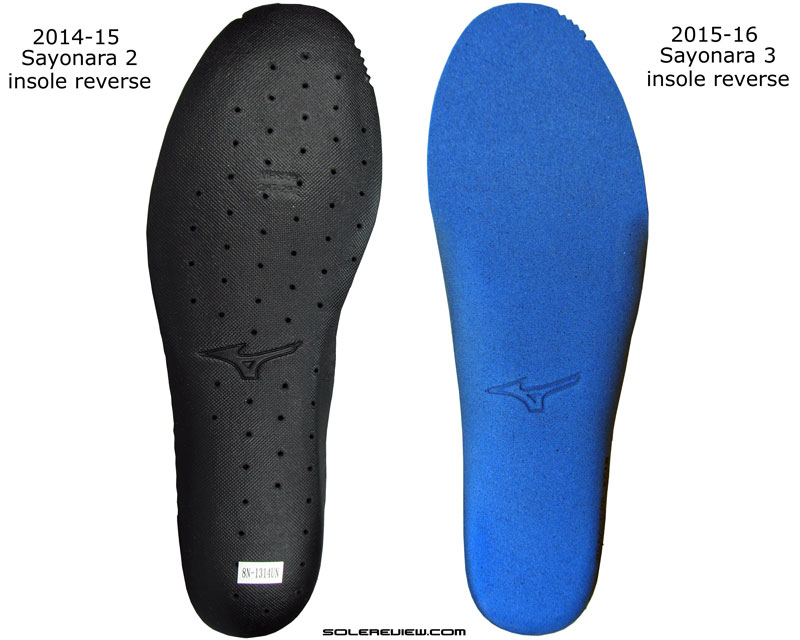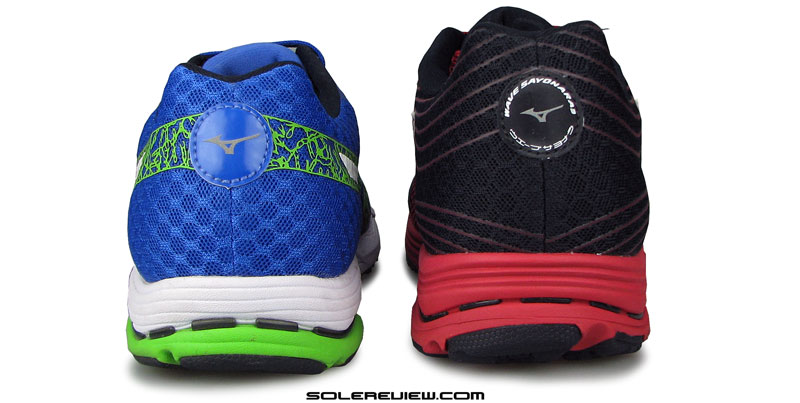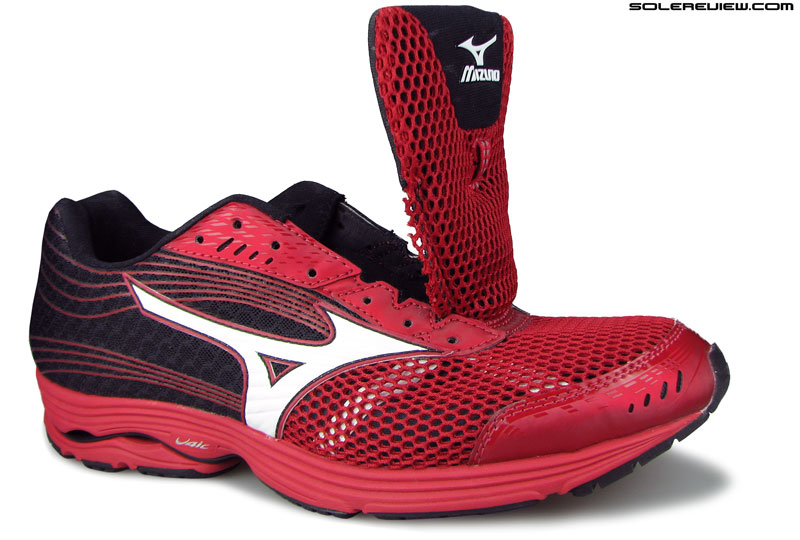By most standards, the Mizuno Wave Sayonara 3 can be described as a comfortable shoe. The blown foam insole is soft and cushy, and there’s an EVA midsole of decent thickness. Save for the inner midfoot tapes, the upper fits decently.
Also, at 287 gms/ 10.1 oz for a US 11, it performs well on the weighing scale too. The outsole forefoot consists of soft blown rubber, and the rearfoot is covered with a hard wearing rubber compound. All these features are classic ingredients of a cushioned daily trainer, and that is exactly why we gave the Mizuno Wave Sayonara 3 a lowly score of 65%.
Huh? That doesn’t make any sense at all.
Let’s say you had to get some plumbing improvements done in your kitchen, so you hire a contractor highly recommended by one of your friends. The contractor arrives at your doorstep the next day as promised. But instead of fixing your leaky pipes, he proceeds to the living room and does a very decent job of redecorating it.
Which is great, because at some point in the future you were planning to do that anyway – when you had the budget for it, that is. But today was the day for a plumber and not an interior decorator, regardless of a job well done.
You are obviously very disappointed with the unexpected turn of events. Your kitchen faucet still drips incessantly, and the redecorated living room proves to be of little consolation.

If you loved the snappy Sayonara 2, it is in your best interest to give the Sayonara 3 a wide berth.
So the point is – if you wanted to buy a relatively cushioned Mizuno for your daily training needs, that is a job for the Wave Rider 19, and not the Sayonara 3. And that’s precisely how the 2016 Wave Sayonara 3 runs like – a cushioned trainer.
So what exactly is wrong with this picture?
Because the Sayonara 3 is coming off the back of the excellent Sayonara 2. We know, it’s been a while, so let’s rewind to last year. The Sayonara 2 had a firm ride resulting from the harder midsole, a supportive heel Wave plate design and a denser, responsive insole.
The Sayonara 2 did a great job on traction too. The DSP (Dual Stencil Process) outsole forefoot design provided a level of grip which would have made a racing flat proud, and cut down on weight too. The Sayonara 2 was 255 gms/9.1 Oz for a US 11, which is as lightweight as they come. For the aforementioned reasons, the shoe also doubled as a good track training tool.
All these elements tossed together helped the S-2 achieve a superlative transition quality, making the midsole ride feel efficient and fast. The upper was a single piece mesh construction, with all overlays welded and the inner tapes fused. Which of course, bode well for the quality of upper fit.
Now we’ll begin describing the Mizuno Wave Sayonara 3, and you’ll soon realise why the 2016 update is a blunder of monumental proportions.
The upper heads in a completely different direction. Instead of possessing the aesthetic grace of the previous Sayonara’s upper, and the Sayo 3’s upper is a pitiful visual mess.
It begins with a stitched toe-bumper made of regular synthetic, which joins the forefoot area made of spacer mesh.

Mizuno makes some puzzling design choices. Like these stitched-on straps between the air mesh and the lining.
Since the forefoot mesh doesn’t have the structure to retain its shape by itself, Mizuno has resorted to using two stitched tapes underneath to prop the mesh up. That is followed by a gratuitous Mizuno logo, which happens to be stitched over the midfoot. That results in two stitched tapes inside the upper.
There’s more synthetic used as the foundation for the lacing area, under which a padded tongue borrows the forefoot spacer mesh for its upper layer.
As if to somehow compensate for the aesthetic downgrade of the Sayonara 3, Mizuno has these wavy lines extending from the midfoot to the heel.
That happens to be just another disconnected piece in the puzzling miss-mash the new design is. At least the Sayonara 2’s fused overlays had a functional side to them.
The changes on the Sayonara 3 does not stop at the upper. Remove the sockliner to compare it with the previous version, and you’ll notice a major difference. The Sayonara 2 had a responsive insole made of compressed foam with a smooth skin, whereas the Sayonara 3 uses a blown foam variety.
A suite of updates have been applied to the sole as well. The midsole foam goes down a level in density, the heel Wave plate design has changed, and most importantly, the outsole design undergoes a complete transformation.
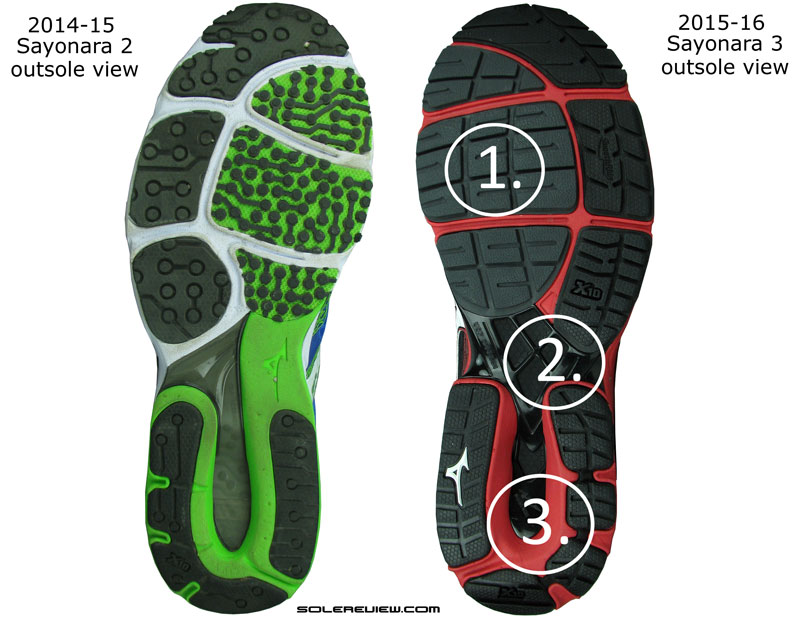
1) DSP section replaced by regular blown rubber 2) Midfoot EVA fill removed 3) Rounded heel profile, lower contact area
The entire outsole design has been overhauled, the basis of which are three major changes. The first part concerns replacing the DSP part with regular rubber under the forefoot.
The Sayonara 2 had these small rubber lugs mounted on a fabric base, a construction often seen on thoroughbred race-day flats. Well, that’s gone on the 3rd version.

The Sayonara 3 leaves the inner midfoot area exposed, not covering the plastic with foam like on the S-2.
Move over to the midfoot section, and there’s a glaring gap on the medial (inner) side. While the Sayonara 2 had this part nicely filled up, the Sayonara 3 does exactly the opposite. It removes the foam covering the midfoot part of the plastic Wave plate, creating an outsole break in the process.
Lastly, the outsole pieces are mounted higher on the midsole instead of being flush with the foam – like how the Sayonara 2 did it.
To cut a long tale short, the Sayonara 3 is a completely different shoe than the Sayonara 2. Just goes to show that a running shoe is only as good as its last version, and pedigree counts for nothing.
If you really loved the Sayonara 2 (we did), you should stick to it if you can. Stocks of the S2 are still available online and elsewhere. So all these major updates translate into equally radical changes in fit and feel, correct? Right on, dude.
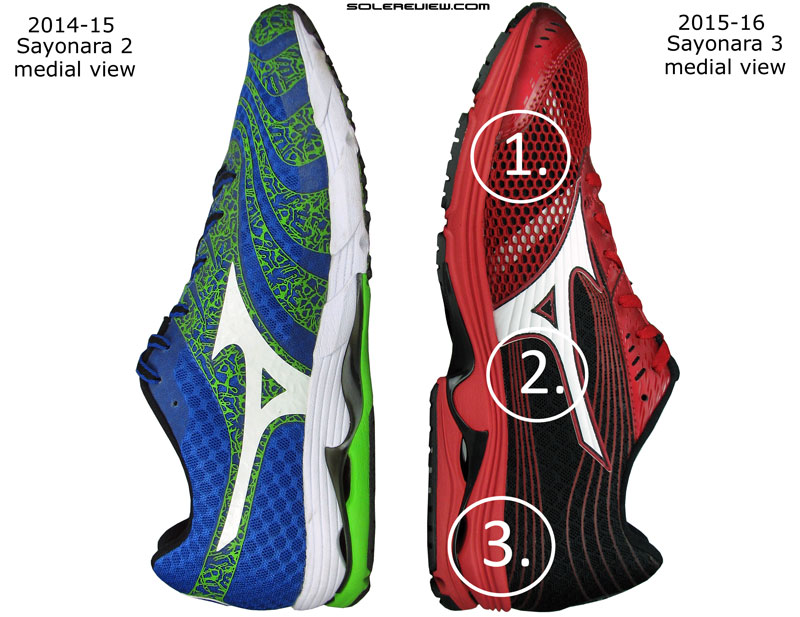
1) Tighter medial forefoot due to the white inner V-strap 2) Narrower midfoot because of stitched inner seams 3) Softer midsole foam
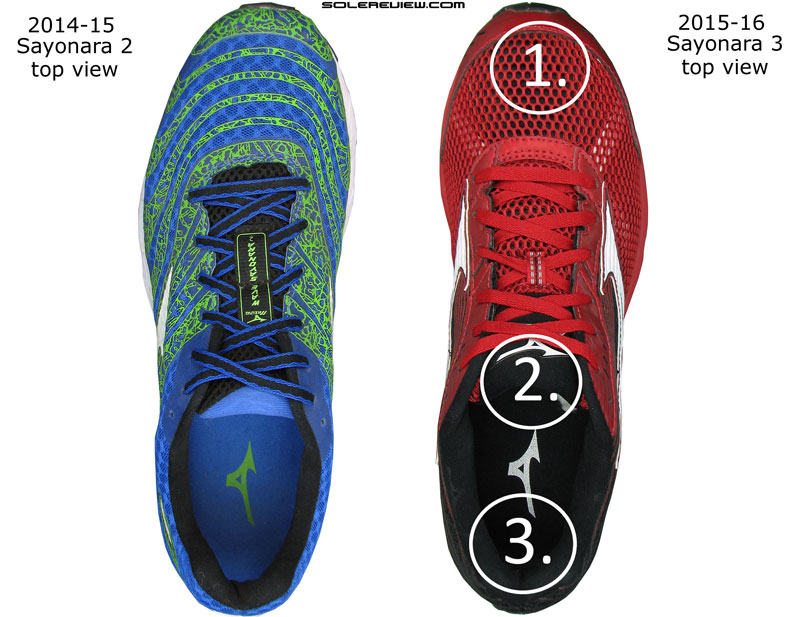
1) Seamless toe-bumper converts to a stitched-over type 2) Increased tongue flap padding 3) Increased foam fill within the collar walls.
The Mizuno Sayonara 3 is an odd one. Because for a shoe which appears wider than the Sayonara 2, it is actually narrower in fit. This is experienced on the medial (inner) side, where two completely unnecessary materials influence the fit.
Under the forefoot lies two white bands stitched over the lining in a ‘V’ shape. This reduces the amount of space available alongside the big toe, making that area feel tighter. No complaints with the sizing though, which stays true.
Move over to the midfoot, and the infamous stitched-over tapes make their appearance. It is truly baffling why Mizuno chose to abandon the fused tapes of the Sayonara 2 and substitute it with stitched-over materials.
By doing so, Mizuno has managed to trade the smooth midfoot interiors of the Sayonara 2 for a tighter, relatively uncomfortable fit (no more than other Mizuno shoes, though) of the newest model.

All Mizuno heel collars look similar, but we felt the presence of increased foam behind that lining.
Can’t be absolutely certain, but the heel collar seems to be packed with more foam. The top edges are softer too; the Sayonara 2’s firmer collar was felt beneath the ankles, and that sensation dissipates with the Sayonara 3. The tongue top padding has definitely increased, and as you can observe in the image above.
And all this just leads to the conclusion that the Sayonara 3’s upper feels like just any other Mizuno, with the interiors having lost the uninterrupted/smooth feel of the outgoing Sayonara 2. Not due to the padded collar or tongue, but rather the handiwork of the inner tapes used to line the interiors.
If there’s any part which truly determines the character of a running shoe, it’s the midsole and outsole. Small updates can have a significant impact on how the shoe rides, and the sweeping alterations to the Sayonara 3’s sole makes the shoe completely different.
Within the first mile of running in the Sayonara 3, any expectations you had of it as a fast shoe quickly evaporates. Ok, let’s rephrase the last statement. While no shoe truly makes you run fast, but it feels far better to have one which complements your pace and workout.
A leisurely run is well matched by a cushioned, easy-going shoe. Conversely, if you want a shoe to go with your quick runs, then the last year’s Sayonara was the ideal foot-companion.
Its DSP outsole had a lot of bite, and the overall firm tone of the shoe contributed to the Sayonara 2’s agile, precise feel. The firmer insole, midsole, Wave plate and forefoot made that effect happen.

The thick layer of blown rubber under the forefoot blunts what used to be the Sayonara 2’s purposeful nature.
The Sayonara 3 feels blunt in comparison. The forefoot is now plain (and thicker) blown rubber, so that dilutes the level of ground feel experienced previously. It is more padded – yes, but ends up feeling like one of the many cushioned trainers available.
It also loses a lot of grip afforded by the small rubber lugs mounted on the S-2’s textile base.
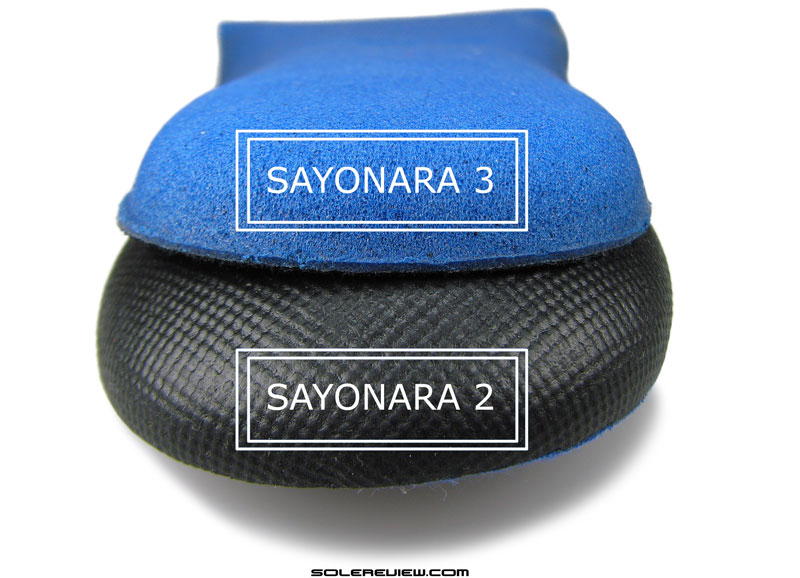
Here’s looking at the insole material change in detail. The S-2 (below in black) came with a more responsive insole.
In addition, two other factors end up making the S-3 a much softer shoe. The new insole is blown foam, remember?
That is comparatively mushy, and lacks the responsiveness wrought upon by the firmer S-2 insole.

Even the Sayonara 2 had a Wave plate, but to understand the difference, see the side-by-side comparison picture below.

1) The addition of the updated insole and blown rubber outsole makes the forefoot softer 2) The design of the Wave plate changes on the lateral side.
The second factor is the redesigned heel area. Besides the insole, there are a few more design updates which turn the ride softer. The Wave plate design has changed to become asymmetrical.
The S-2 had an uniform ‘Wave’ design on either sides; in contrast the S-3 has a gentler lateral side than the medial (inner) side. The gradual Wave design allows the heel to compress more on the lateral side, hence increasing the Sayonara 3’s softness.
Using the term ‘softness’ is relative to a Mizuno; all of its shoes have a firm accent owing to the use of the hard plastic plate. But then, we’re comparing the Sayonara 3 to the 2, and the difference is absolutely noticeable.

The softer midsole foam and revised Wave plate combine to make the Sayonara 3 run softer than the V2.
Some part of the increased cushioning softness can be attributed to the changed midsole foam density, which turns slightly softer. And lastly, the outsole bits stick out higher than the S-2, creating a compression effect upon weight loading.
The S-2’s heel outsole was also flatter in profile, increasing the contact area. This made the ride firmer, and smoother too.

Softer foam+pliable Wave+outsole design+missing midfoot foam = lazier transitions compared to the Sayonara 2.
The missing chunk of midfoot outsole foam does make a difference in the transition quality. The S-2’s filled-up midfoot made transitions feel progressive, compared to the Sayonara 3’s exposed shank design – which honestly feels more like a Wave Rider 19 than the previous Sayonara 2.
So there is a bright side to this fiasco, after all. The Sayonara 2 felt great as a shoe for anything between a fast 5K to a half-marathon; anything more than that, and the shoe felt a bit cushion-starved for your liking. With the updates, the extra dose of softness on the Sayonara 3 feels more comfortable for longer distances.

The Runbird logo is also disappointed with the newest edition. Otherwise, why else would it be printed upside down on the lining?
But that wasn’t the point of the Sayonara, was it? Every shoe has a purpose, and the recently departed Sayonara 2’s legacy is trampled over with soft cushioning.
Sometimes, being a decent daily trainer simply doesn’t cut it. For within Mizuno’s small universe of running shoes, each model is expected to perform a particular job. Look at it that way, and this year’s Sayonara 3 is a slacker.
Context is everything, like they say.
(Disclaimer: For this review, Solereview bought the shoe at full US retail price.)
Looking to upgrade your 2014-15 Sayonara 2 to the latest version, but not sure how the latest 2016 model compares? We can help here. The following info-graphic is a ready-reckoner for what changes you might expect in the new model vs. old. To make this more fun, we’ve put in a system of percentage match, which calculates a weighted average for a set of attributes.
A higher or lower match percentage is neither good or bad. The % number just tells you how similar or distanced the new shoe is from the previous version. Total match % is a result of weighted averages.


